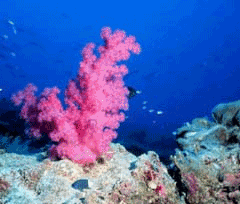A new study has found that the damage caused by human activity to some of the world's iconic coral reefs in the past 30 years is greater than at any time in the last 220,000 years.
Research by Associate Professor John Pandolfi, a Chief Investigator in the ARC Centre of Excellence for Coral Reef Studies (CoECRS) and The University of Queensland, sounds a warning that the world's reefs have never experienced changes quite like the ones they are now facing.
The paper published in the science journal Ecology Letters found coral reefs in the Caribbean island Barbados remained very much the same over a period of almost 100,000 years before humans appeared there. The startling finding, however, is that the modern day reefs are now vastly different and dominated by completely different species compared to anything seen in its past.
“The reefs have shown remarkable persistence over tens of thousands of years,” Dr Pandolfi said.
“Our biggest fear is that humans have pushed them to a completely different state where they are far more vulnerable and susceptible to change than ever before. We have to be on guard.”
Dr Pandolfi's study looked at the preserved remains of entire coral reef communities that lived in the Caribbean up to 220,000 years ago. By looking at these coral reefs “frozen in time” he was able to see exactly what made up the structure of the ancient reef – the individual coral species and their abundances.
By comparing the structure of coral reef communities at four periods over almost 100,000 years he found they were all remarkably similar. In each period, the same species predominated and occurred in very similar numbers.
The four reefs built upward during sea level rise after sea level falls; an event where the community is completely wiped out as geological movements push the reef above the surface, and expose new seafloor to be recolonised. On each occasion, the coral reef returned to a very similar community structure as before – a testament to its resilience to change.
Dr Pandolfi said indications that Caribbean coral reef communities persisted through hundreds of thousands of years of hurricane, climate and sea level fluctuations does not mean we can assume they will always persist, especially in the face of human impacts.
“In the past, you would have seen an overwhelming dominance of Elkhorn coral. It was one of the most beautiful and striking features of the Caribbean reefs,” Dr Pandolfi said.
“Now, [that species] has virtually disappeared and the same reefs are dominated by algae and seaweed.
“There are precious few large fish, turtles, dugongs, or sharks. It is totally different to the past.”
So different, in fact, that the once-persistent community structure has not returned for the past three decades. The species that once dominated are now almost completely gone and the structure of the community is like nothing he has recorded in the reef's past.
The change in Barbados and throughout the Caribbean is due largely to overfishing, erosion and coastal land clearing – the same sort of events impacting reefs worldwide, including the Great Barrier Reef.
The study warns that strong management efforts must be made to ensure that coral reef communities like the Great Barrier Reef remain fighting fit.
“This study is a warning bell that if Australia is not proactive in its coral reef management we will see similar changes in the Great Barrier Reef,” Dr Pandolfi said.
“If our reefs are going to survive the impacts of climate change, they have to be at the peak of their health.”
Dr Pandolfi said Australia was uniquely positioned to set the standard for reef preservation worldwide and that research centres such as CoECRS were providing expertise to help protect Australia`s reefs and the reefs of its neighbours.
Source: University of Queensland
























